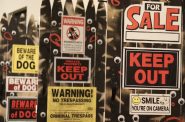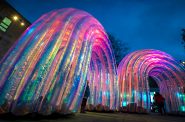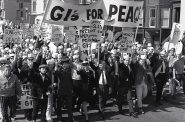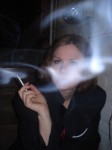Street Seen photography show at MAM

William Klein, Christmas Shopping, Macy’s New York, 1954. Gelatin silver print, 11 x 13 7/8 in. The Metropolitan Museum of Art, Purchase, The Horace W. Goldsmith Foundation Gift, through Joyce and Robert Menschel, 1989 (1989.1037.1). ©William Klein
Yes, you take a camera and point it at something in the real world, and you capture an image in one way or another. But that doesn’t mean the image expresses an unchanging, objective Truth. You have captured a moment in time, viewed through a specific lens, not only the lens of the camera but also the lens of your own understanding. The image might be the truth, but it might be more subjective and transient than truth.
_
Street Seen, at the Milwaukee Art Museum, brings together images by photographers who worked at the forefront of this sort of thinking. They moved photography away from strict documentation and toward interpretation. The six featured artists all had work published in news journals, but none worked within the confines of photojournalism. They embraced the artistic trends of the time by experimenting with motion, emotion, abstraction and spontaneity.

Street Seen features Ted Croner, one of the more interesting technical photographers of the 1940s. Croner once said that he did “not take pictures of people, but pictures of feelings.” In order to give freer rein to the emotive content of his photographs, he experimented heavily with the exposure process and various developing chemicals, some of them altogether new to the field. He was an active participant in the photographic process. He did not merely snap a shot and then put it on paper. He changed the image between capture and print. His interpretation and his emotional state influenced the final product.

Lisette Model, Running Legs, New York, 1940. Gelatin silver print, 39 3/4 32 in. International Center of Photography, Gift of Lisette Model Foundation in memory of Joseph G. Blum, 1993. ©The Lisette Model Foundation, Inc. (1983).
An undercurrent of eroticism runs through the work of Lisette Model, who emigrated from France at the end of the war and worked in New York. She mostly photographed women; women walking, standing, sitting. She produced a whole series of photographs of people walking the streets of the city, with striking images of hose and pumps, of calves peeping out beneath the hems of their coats as women hurry on their way. The legs are impossible to miss and undeniably sensual against a backdrop of concrete streets and men’s shoes.
_
Art
-
Winning Artists Works on Display
 May 30th, 2024 by Annie Raab
May 30th, 2024 by Annie Raab
-
5 Huge Rainbow Arcs Coming To Downtown
 Apr 29th, 2024 by Jeramey Jannene
Apr 29th, 2024 by Jeramey Jannene
-
Exhibit Tells Story of Vietnam War Resistors in the Military
 Mar 29th, 2024 by Bill Christofferson
Mar 29th, 2024 by Bill Christofferson



















Very nice, Ryan. An excellent perspective on not just what is the exhibit, but why and how.
I have a Klein photograph I purchased from Jensen Gallery a few years ago. Klein, by the way, is alive and well and living in Paris where he recently had a major retrospective. Anyway, my image is of corpulent ladies posing in a steam bath somewhere in Paris. Some of the ladies look straight out of Fellini….